Employment Law Case Study: Analysis of Athena's Legal Standing
VerifiedAdded on 2023/06/15
|9
|2102
|113
Case Study
AI Summary
This case study examines the employment law issues surrounding Athena, a Chinese migrant, and her employment relationship with Chinatown and Restaurant Services Pty Ltd. It addresses whether Athena had the capacity to enter into a valid employment contract, considering her migrant status. The study analyzes whether Athena remained an employee of Chinatown after tendering her resignation, applying common law tests like the control test and multi-factor test to determine her employment type. Furthermore, it investigates potential breaches of the Fair Work Act, specifically focusing on sham contracting arrangements where Chinatown allegedly misrepresented Athena's status as an independent contractor to avoid employer obligations. The analysis concludes that Athena was likely an employee of Chinatown even after her resignation and that Chinatown may have violated federal legislation related to sham contracting, potentially leading to an investigation by Fair Work Inspectors and remedial damages for Athena. Desklib provides access to similar solved assignments and study resources for students.

Employment Law
Paraphrase This Document
Need a fresh take? Get an instant paraphrase of this document with our AI Paraphraser
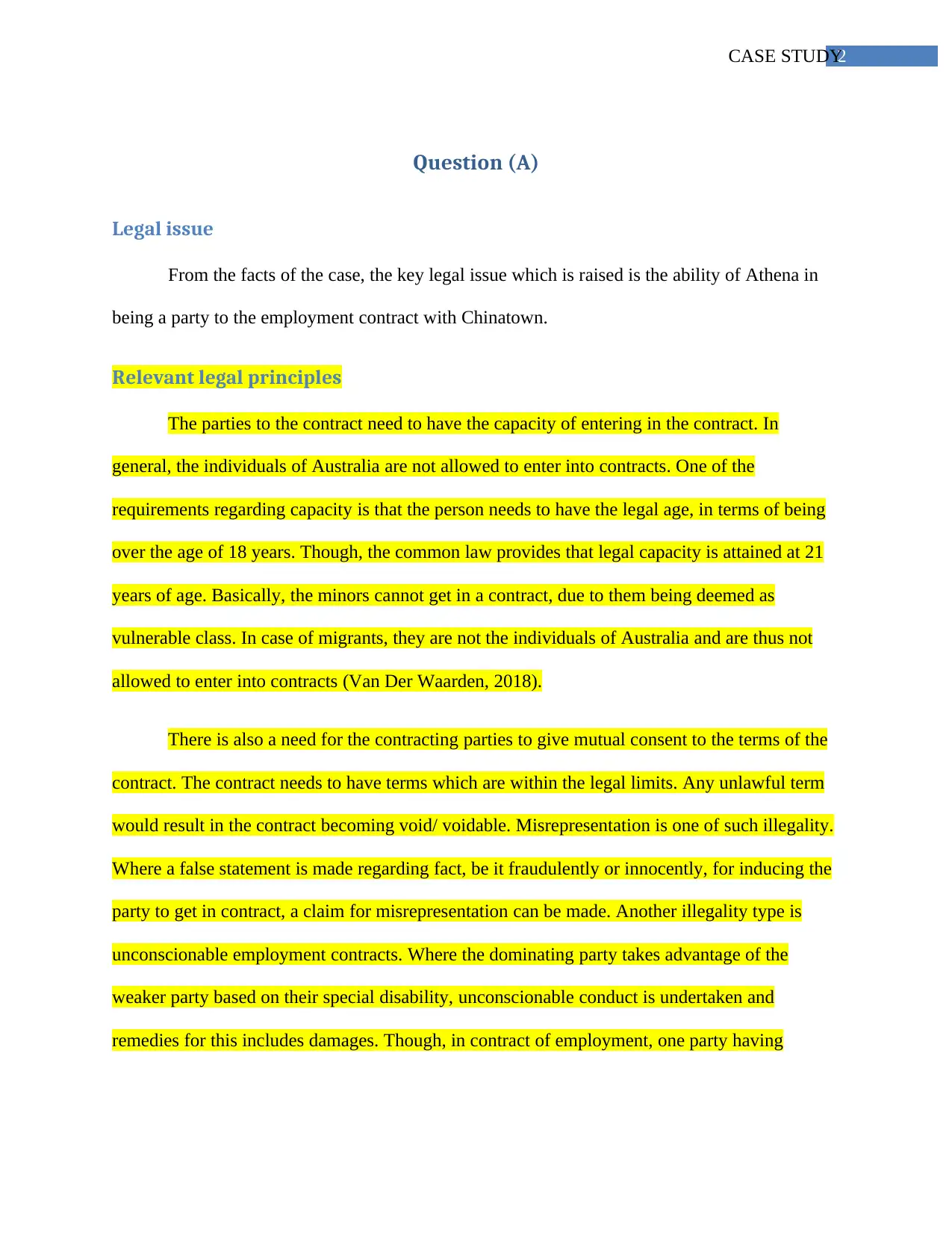
2CASE STUDY
Question (A)
Legal issue
From the facts of the case, the key legal issue which is raised is the ability of Athena in
being a party to the employment contract with Chinatown.
Relevant legal principles
The parties to the contract need to have the capacity of entering in the contract. In
general, the individuals of Australia are not allowed to enter into contracts. One of the
requirements regarding capacity is that the person needs to have the legal age, in terms of being
over the age of 18 years. Though, the common law provides that legal capacity is attained at 21
years of age. Basically, the minors cannot get in a contract, due to them being deemed as
vulnerable class. In case of migrants, they are not the individuals of Australia and are thus not
allowed to enter into contracts (Van Der Waarden, 2018).
There is also a need for the contracting parties to give mutual consent to the terms of the
contract. The contract needs to have terms which are within the legal limits. Any unlawful term
would result in the contract becoming void/ voidable. Misrepresentation is one of such illegality.
Where a false statement is made regarding fact, be it fraudulently or innocently, for inducing the
party to get in contract, a claim for misrepresentation can be made. Another illegality type is
unconscionable employment contracts. Where the dominating party takes advantage of the
weaker party based on their special disability, unconscionable conduct is undertaken and
remedies for this includes damages. Though, in contract of employment, one party having
Question (A)
Legal issue
From the facts of the case, the key legal issue which is raised is the ability of Athena in
being a party to the employment contract with Chinatown.
Relevant legal principles
The parties to the contract need to have the capacity of entering in the contract. In
general, the individuals of Australia are not allowed to enter into contracts. One of the
requirements regarding capacity is that the person needs to have the legal age, in terms of being
over the age of 18 years. Though, the common law provides that legal capacity is attained at 21
years of age. Basically, the minors cannot get in a contract, due to them being deemed as
vulnerable class. In case of migrants, they are not the individuals of Australia and are thus not
allowed to enter into contracts (Van Der Waarden, 2018).
There is also a need for the contracting parties to give mutual consent to the terms of the
contract. The contract needs to have terms which are within the legal limits. Any unlawful term
would result in the contract becoming void/ voidable. Misrepresentation is one of such illegality.
Where a false statement is made regarding fact, be it fraudulently or innocently, for inducing the
party to get in contract, a claim for misrepresentation can be made. Another illegality type is
unconscionable employment contracts. Where the dominating party takes advantage of the
weaker party based on their special disability, unconscionable conduct is undertaken and
remedies for this includes damages. Though, in contract of employment, one party having
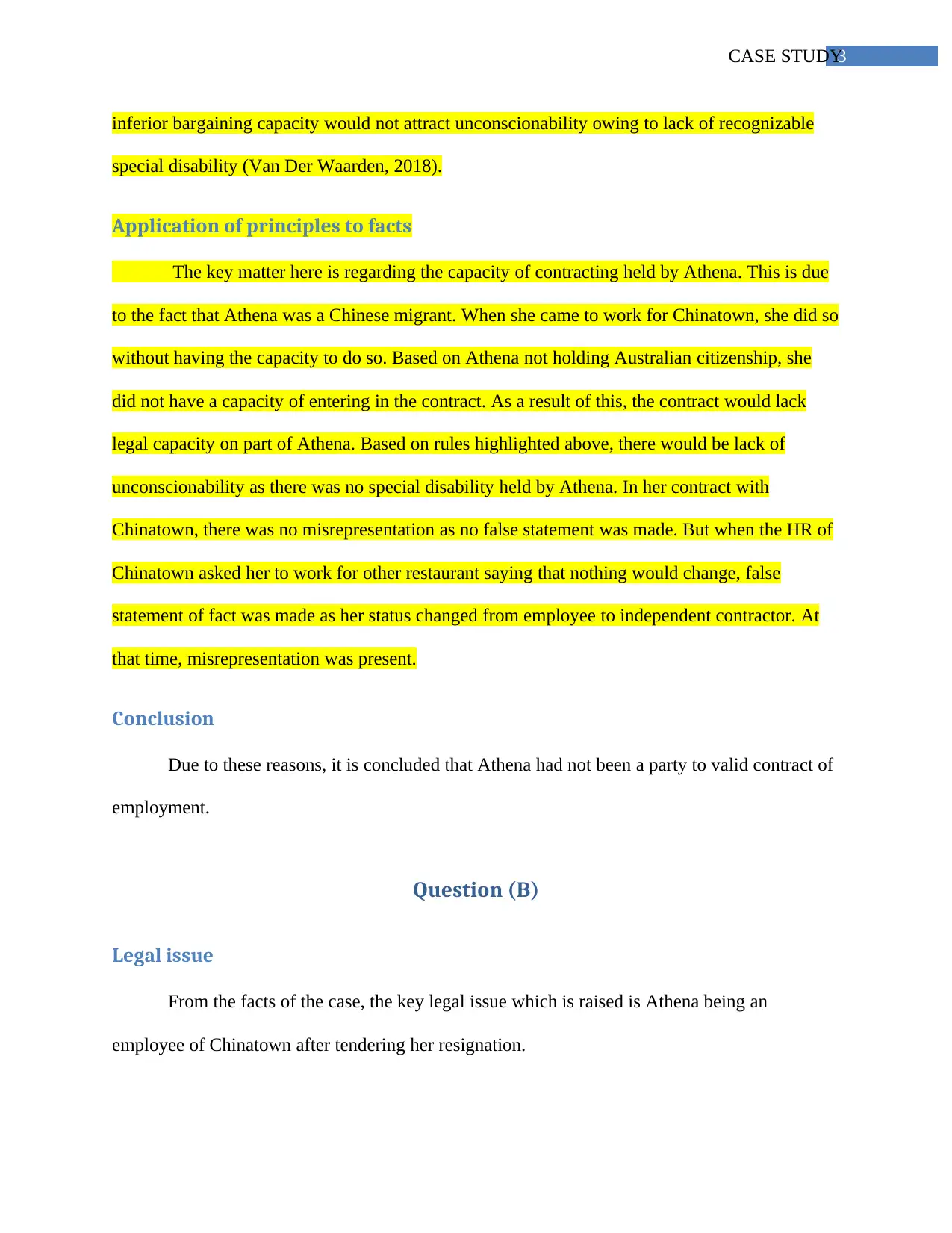
3CASE STUDY
inferior bargaining capacity would not attract unconscionability owing to lack of recognizable
special disability (Van Der Waarden, 2018).
Application of principles to facts
The key matter here is regarding the capacity of contracting held by Athena. This is due
to the fact that Athena was a Chinese migrant. When she came to work for Chinatown, she did so
without having the capacity to do so. Based on Athena not holding Australian citizenship, she
did not have a capacity of entering in the contract. As a result of this, the contract would lack
legal capacity on part of Athena. Based on rules highlighted above, there would be lack of
unconscionability as there was no special disability held by Athena. In her contract with
Chinatown, there was no misrepresentation as no false statement was made. But when the HR of
Chinatown asked her to work for other restaurant saying that nothing would change, false
statement of fact was made as her status changed from employee to independent contractor. At
that time, misrepresentation was present.
Conclusion
Due to these reasons, it is concluded that Athena had not been a party to valid contract of
employment.
Question (B)
Legal issue
From the facts of the case, the key legal issue which is raised is Athena being an
employee of Chinatown after tendering her resignation.
inferior bargaining capacity would not attract unconscionability owing to lack of recognizable
special disability (Van Der Waarden, 2018).
Application of principles to facts
The key matter here is regarding the capacity of contracting held by Athena. This is due
to the fact that Athena was a Chinese migrant. When she came to work for Chinatown, she did so
without having the capacity to do so. Based on Athena not holding Australian citizenship, she
did not have a capacity of entering in the contract. As a result of this, the contract would lack
legal capacity on part of Athena. Based on rules highlighted above, there would be lack of
unconscionability as there was no special disability held by Athena. In her contract with
Chinatown, there was no misrepresentation as no false statement was made. But when the HR of
Chinatown asked her to work for other restaurant saying that nothing would change, false
statement of fact was made as her status changed from employee to independent contractor. At
that time, misrepresentation was present.
Conclusion
Due to these reasons, it is concluded that Athena had not been a party to valid contract of
employment.
Question (B)
Legal issue
From the facts of the case, the key legal issue which is raised is Athena being an
employee of Chinatown after tendering her resignation.
⊘ This is a preview!⊘
Do you want full access?
Subscribe today to unlock all pages.

Trusted by 1+ million students worldwide
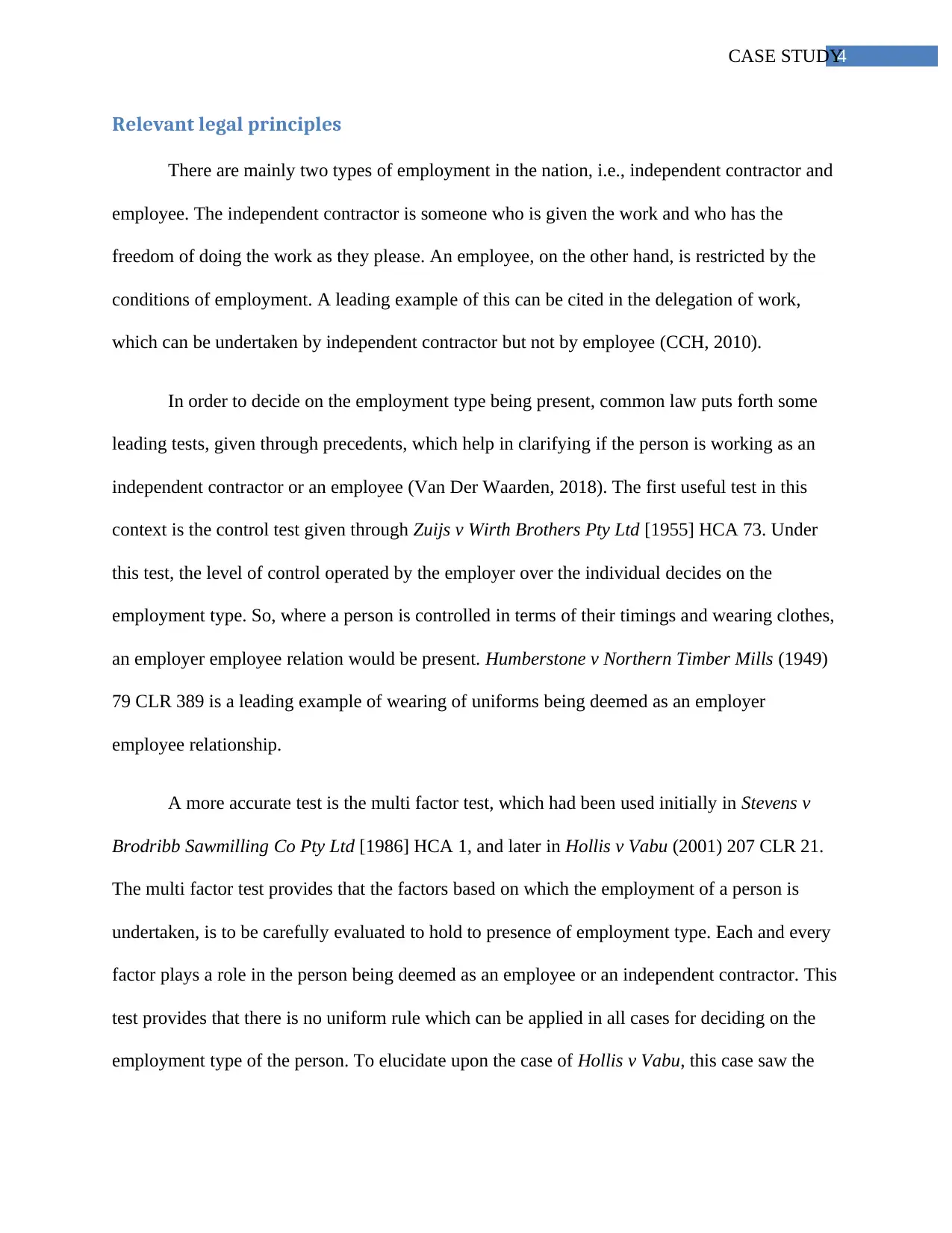
4CASE STUDY
Relevant legal principles
There are mainly two types of employment in the nation, i.e., independent contractor and
employee. The independent contractor is someone who is given the work and who has the
freedom of doing the work as they please. An employee, on the other hand, is restricted by the
conditions of employment. A leading example of this can be cited in the delegation of work,
which can be undertaken by independent contractor but not by employee (CCH, 2010).
In order to decide on the employment type being present, common law puts forth some
leading tests, given through precedents, which help in clarifying if the person is working as an
independent contractor or an employee (Van Der Waarden, 2018). The first useful test in this
context is the control test given through Zuijs v Wirth Brothers Pty Ltd [1955] HCA 73. Under
this test, the level of control operated by the employer over the individual decides on the
employment type. So, where a person is controlled in terms of their timings and wearing clothes,
an employer employee relation would be present. Humberstone v Northern Timber Mills (1949)
79 CLR 389 is a leading example of wearing of uniforms being deemed as an employer
employee relationship.
A more accurate test is the multi factor test, which had been used initially in Stevens v
Brodribb Sawmilling Co Pty Ltd [1986] HCA 1, and later in Hollis v Vabu (2001) 207 CLR 21.
The multi factor test provides that the factors based on which the employment of a person is
undertaken, is to be carefully evaluated to hold to presence of employment type. Each and every
factor plays a role in the person being deemed as an employee or an independent contractor. This
test provides that there is no uniform rule which can be applied in all cases for deciding on the
employment type of the person. To elucidate upon the case of Hollis v Vabu, this case saw the
Relevant legal principles
There are mainly two types of employment in the nation, i.e., independent contractor and
employee. The independent contractor is someone who is given the work and who has the
freedom of doing the work as they please. An employee, on the other hand, is restricted by the
conditions of employment. A leading example of this can be cited in the delegation of work,
which can be undertaken by independent contractor but not by employee (CCH, 2010).
In order to decide on the employment type being present, common law puts forth some
leading tests, given through precedents, which help in clarifying if the person is working as an
independent contractor or an employee (Van Der Waarden, 2018). The first useful test in this
context is the control test given through Zuijs v Wirth Brothers Pty Ltd [1955] HCA 73. Under
this test, the level of control operated by the employer over the individual decides on the
employment type. So, where a person is controlled in terms of their timings and wearing clothes,
an employer employee relation would be present. Humberstone v Northern Timber Mills (1949)
79 CLR 389 is a leading example of wearing of uniforms being deemed as an employer
employee relationship.
A more accurate test is the multi factor test, which had been used initially in Stevens v
Brodribb Sawmilling Co Pty Ltd [1986] HCA 1, and later in Hollis v Vabu (2001) 207 CLR 21.
The multi factor test provides that the factors based on which the employment of a person is
undertaken, is to be carefully evaluated to hold to presence of employment type. Each and every
factor plays a role in the person being deemed as an employee or an independent contractor. This
test provides that there is no uniform rule which can be applied in all cases for deciding on the
employment type of the person. To elucidate upon the case of Hollis v Vabu, this case saw the
Paraphrase This Document
Need a fresh take? Get an instant paraphrase of this document with our AI Paraphraser
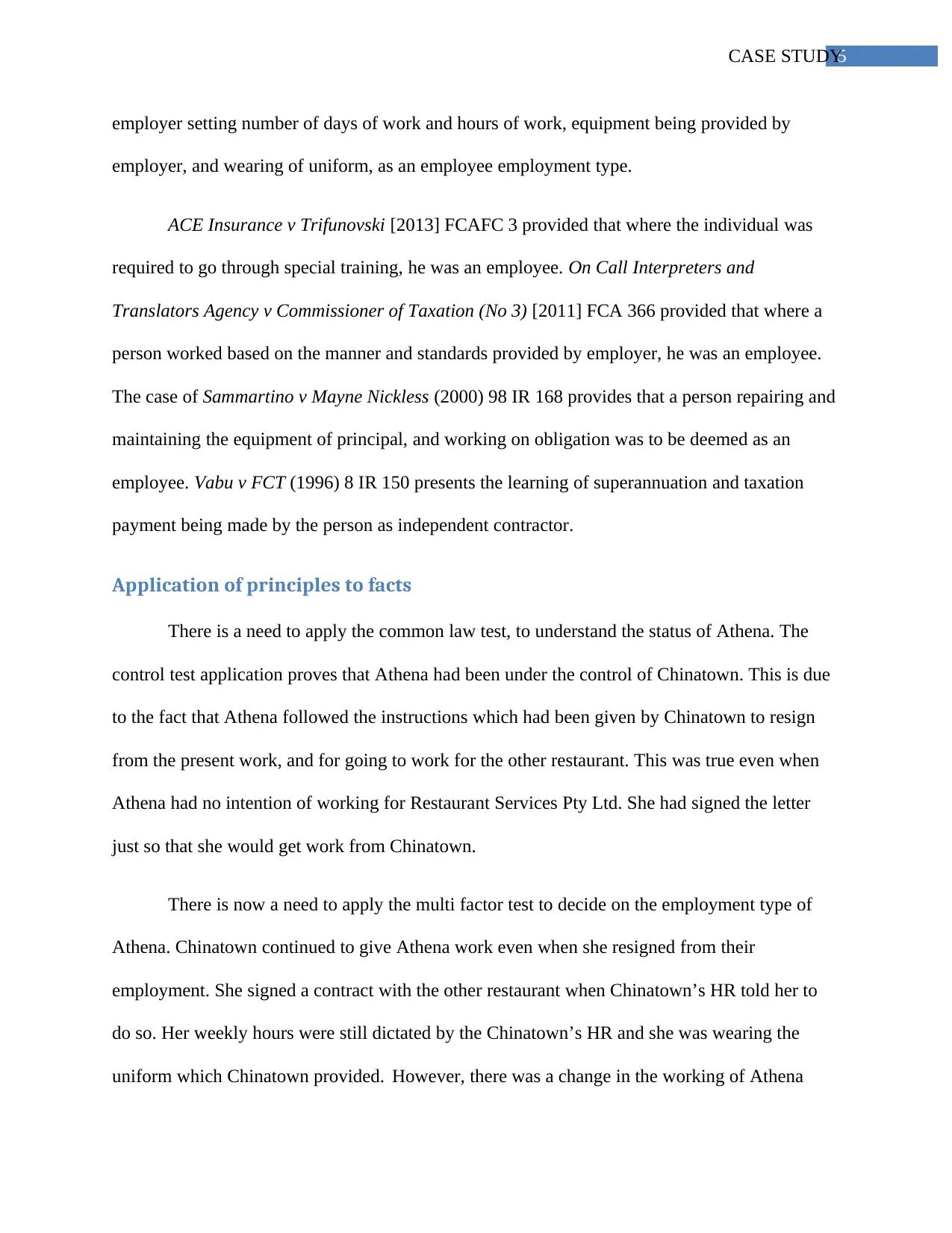
5CASE STUDY
employer setting number of days of work and hours of work, equipment being provided by
employer, and wearing of uniform, as an employee employment type.
ACE Insurance v Trifunovski [2013] FCAFC 3 provided that where the individual was
required to go through special training, he was an employee. On Call Interpreters and
Translators Agency v Commissioner of Taxation (No 3) [2011] FCA 366 provided that where a
person worked based on the manner and standards provided by employer, he was an employee.
The case of Sammartino v Mayne Nickless (2000) 98 IR 168 provides that a person repairing and
maintaining the equipment of principal, and working on obligation was to be deemed as an
employee. Vabu v FCT (1996) 8 IR 150 presents the learning of superannuation and taxation
payment being made by the person as independent contractor.
Application of principles to facts
There is a need to apply the common law test, to understand the status of Athena. The
control test application proves that Athena had been under the control of Chinatown. This is due
to the fact that Athena followed the instructions which had been given by Chinatown to resign
from the present work, and for going to work for the other restaurant. This was true even when
Athena had no intention of working for Restaurant Services Pty Ltd. She had signed the letter
just so that she would get work from Chinatown.
There is now a need to apply the multi factor test to decide on the employment type of
Athena. Chinatown continued to give Athena work even when she resigned from their
employment. She signed a contract with the other restaurant when Chinatown’s HR told her to
do so. Her weekly hours were still dictated by the Chinatown’s HR and she was wearing the
uniform which Chinatown provided. However, there was a change in the working of Athena
employer setting number of days of work and hours of work, equipment being provided by
employer, and wearing of uniform, as an employee employment type.
ACE Insurance v Trifunovski [2013] FCAFC 3 provided that where the individual was
required to go through special training, he was an employee. On Call Interpreters and
Translators Agency v Commissioner of Taxation (No 3) [2011] FCA 366 provided that where a
person worked based on the manner and standards provided by employer, he was an employee.
The case of Sammartino v Mayne Nickless (2000) 98 IR 168 provides that a person repairing and
maintaining the equipment of principal, and working on obligation was to be deemed as an
employee. Vabu v FCT (1996) 8 IR 150 presents the learning of superannuation and taxation
payment being made by the person as independent contractor.
Application of principles to facts
There is a need to apply the common law test, to understand the status of Athena. The
control test application proves that Athena had been under the control of Chinatown. This is due
to the fact that Athena followed the instructions which had been given by Chinatown to resign
from the present work, and for going to work for the other restaurant. This was true even when
Athena had no intention of working for Restaurant Services Pty Ltd. She had signed the letter
just so that she would get work from Chinatown.
There is now a need to apply the multi factor test to decide on the employment type of
Athena. Chinatown continued to give Athena work even when she resigned from their
employment. She signed a contract with the other restaurant when Chinatown’s HR told her to
do so. Her weekly hours were still dictated by the Chinatown’s HR and she was wearing the
uniform which Chinatown provided. However, there was a change in the working of Athena
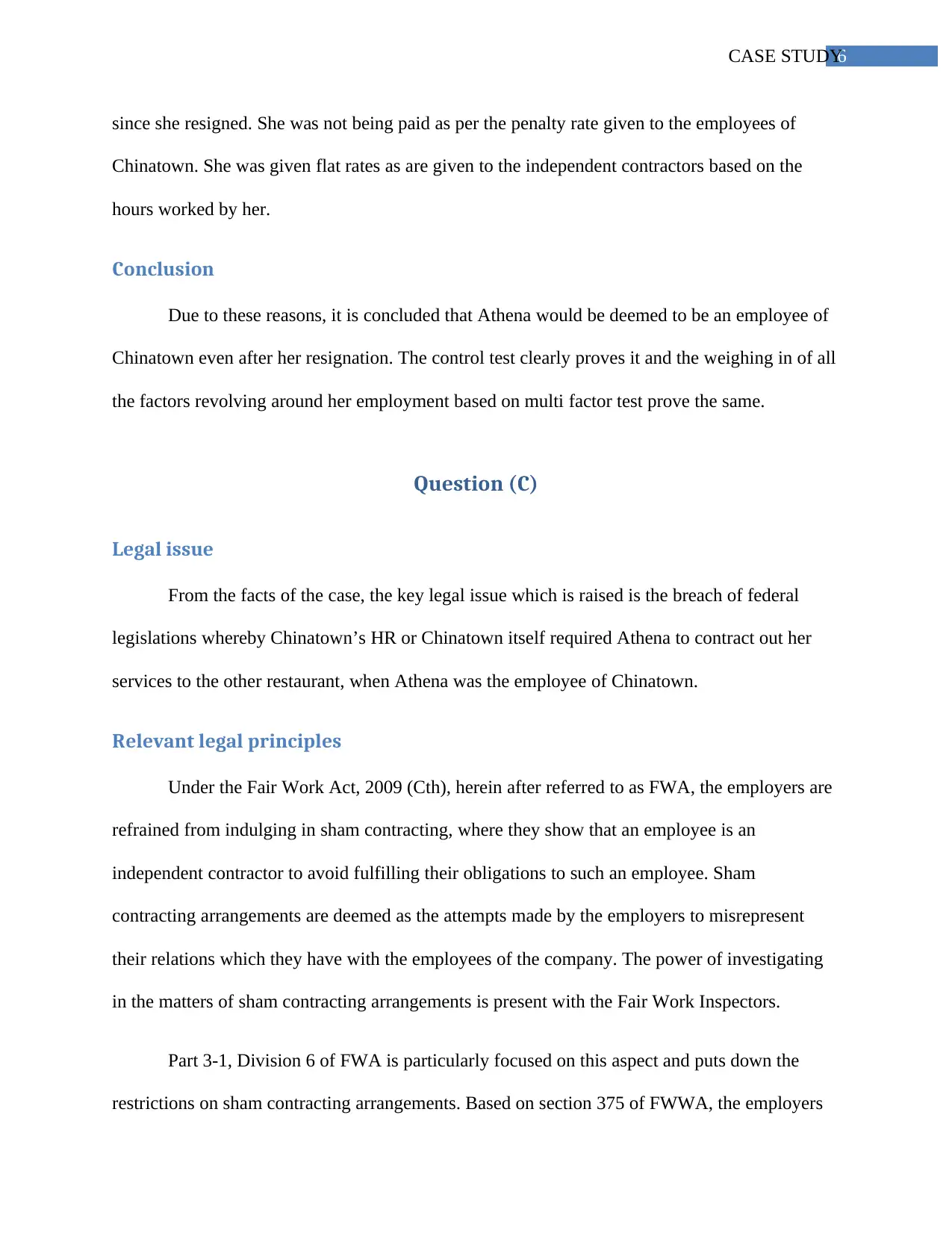
6CASE STUDY
since she resigned. She was not being paid as per the penalty rate given to the employees of
Chinatown. She was given flat rates as are given to the independent contractors based on the
hours worked by her.
Conclusion
Due to these reasons, it is concluded that Athena would be deemed to be an employee of
Chinatown even after her resignation. The control test clearly proves it and the weighing in of all
the factors revolving around her employment based on multi factor test prove the same.
Question (C)
Legal issue
From the facts of the case, the key legal issue which is raised is the breach of federal
legislations whereby Chinatown’s HR or Chinatown itself required Athena to contract out her
services to the other restaurant, when Athena was the employee of Chinatown.
Relevant legal principles
Under the Fair Work Act, 2009 (Cth), herein after referred to as FWA, the employers are
refrained from indulging in sham contracting, where they show that an employee is an
independent contractor to avoid fulfilling their obligations to such an employee. Sham
contracting arrangements are deemed as the attempts made by the employers to misrepresent
their relations which they have with the employees of the company. The power of investigating
in the matters of sham contracting arrangements is present with the Fair Work Inspectors.
Part 3-1, Division 6 of FWA is particularly focused on this aspect and puts down the
restrictions on sham contracting arrangements. Based on section 375 of FWWA, the employers
since she resigned. She was not being paid as per the penalty rate given to the employees of
Chinatown. She was given flat rates as are given to the independent contractors based on the
hours worked by her.
Conclusion
Due to these reasons, it is concluded that Athena would be deemed to be an employee of
Chinatown even after her resignation. The control test clearly proves it and the weighing in of all
the factors revolving around her employment based on multi factor test prove the same.
Question (C)
Legal issue
From the facts of the case, the key legal issue which is raised is the breach of federal
legislations whereby Chinatown’s HR or Chinatown itself required Athena to contract out her
services to the other restaurant, when Athena was the employee of Chinatown.
Relevant legal principles
Under the Fair Work Act, 2009 (Cth), herein after referred to as FWA, the employers are
refrained from indulging in sham contracting, where they show that an employee is an
independent contractor to avoid fulfilling their obligations to such an employee. Sham
contracting arrangements are deemed as the attempts made by the employers to misrepresent
their relations which they have with the employees of the company. The power of investigating
in the matters of sham contracting arrangements is present with the Fair Work Inspectors.
Part 3-1, Division 6 of FWA is particularly focused on this aspect and puts down the
restrictions on sham contracting arrangements. Based on section 375 of FWWA, the employers
⊘ This is a preview!⊘
Do you want full access?
Subscribe today to unlock all pages.

Trusted by 1+ million students worldwide
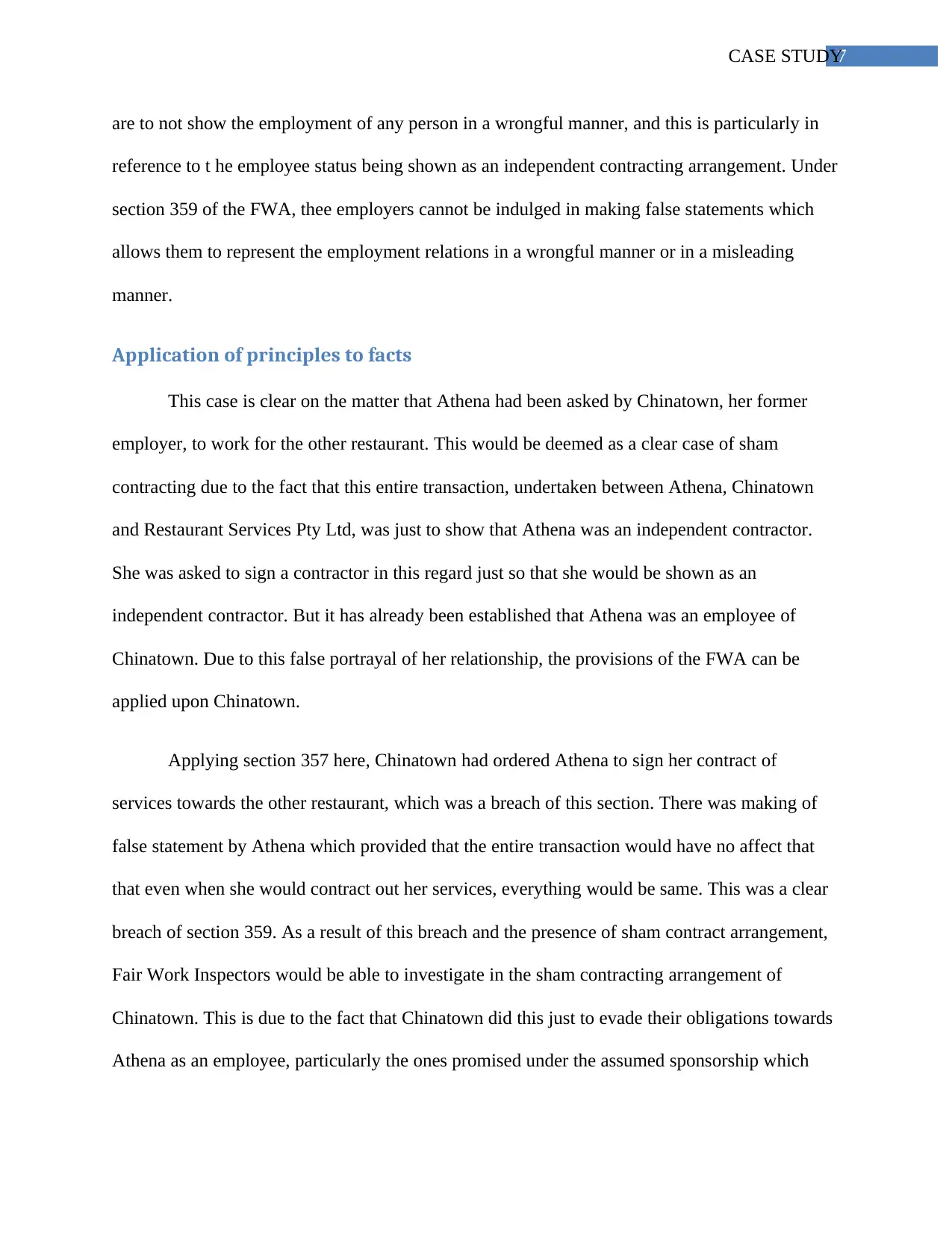
7CASE STUDY
are to not show the employment of any person in a wrongful manner, and this is particularly in
reference to t he employee status being shown as an independent contracting arrangement. Under
section 359 of the FWA, thee employers cannot be indulged in making false statements which
allows them to represent the employment relations in a wrongful manner or in a misleading
manner.
Application of principles to facts
This case is clear on the matter that Athena had been asked by Chinatown, her former
employer, to work for the other restaurant. This would be deemed as a clear case of sham
contracting due to the fact that this entire transaction, undertaken between Athena, Chinatown
and Restaurant Services Pty Ltd, was just to show that Athena was an independent contractor.
She was asked to sign a contractor in this regard just so that she would be shown as an
independent contractor. But it has already been established that Athena was an employee of
Chinatown. Due to this false portrayal of her relationship, the provisions of the FWA can be
applied upon Chinatown.
Applying section 357 here, Chinatown had ordered Athena to sign her contract of
services towards the other restaurant, which was a breach of this section. There was making of
false statement by Athena which provided that the entire transaction would have no affect that
that even when she would contract out her services, everything would be same. This was a clear
breach of section 359. As a result of this breach and the presence of sham contract arrangement,
Fair Work Inspectors would be able to investigate in the sham contracting arrangement of
Chinatown. This is due to the fact that Chinatown did this just to evade their obligations towards
Athena as an employee, particularly the ones promised under the assumed sponsorship which
are to not show the employment of any person in a wrongful manner, and this is particularly in
reference to t he employee status being shown as an independent contracting arrangement. Under
section 359 of the FWA, thee employers cannot be indulged in making false statements which
allows them to represent the employment relations in a wrongful manner or in a misleading
manner.
Application of principles to facts
This case is clear on the matter that Athena had been asked by Chinatown, her former
employer, to work for the other restaurant. This would be deemed as a clear case of sham
contracting due to the fact that this entire transaction, undertaken between Athena, Chinatown
and Restaurant Services Pty Ltd, was just to show that Athena was an independent contractor.
She was asked to sign a contractor in this regard just so that she would be shown as an
independent contractor. But it has already been established that Athena was an employee of
Chinatown. Due to this false portrayal of her relationship, the provisions of the FWA can be
applied upon Chinatown.
Applying section 357 here, Chinatown had ordered Athena to sign her contract of
services towards the other restaurant, which was a breach of this section. There was making of
false statement by Athena which provided that the entire transaction would have no affect that
that even when she would contract out her services, everything would be same. This was a clear
breach of section 359. As a result of this breach and the presence of sham contract arrangement,
Fair Work Inspectors would be able to investigate in the sham contracting arrangement of
Chinatown. This is due to the fact that Chinatown did this just to evade their obligations towards
Athena as an employee, particularly the ones promised under the assumed sponsorship which
Paraphrase This Document
Need a fresh take? Get an instant paraphrase of this document with our AI Paraphraser

8CASE STUDY
Athena would have been provided, with due to her being a Chinese migrant. This would allow
them to award Athena with the relevant remedial damages.
Conclusion
Due to these reasons, it is concluded that Chinatown had been in breach of the federal
legislation of the FWA. This gives an investigation to be launched against Chinatown by Fair
Work Inspectors, in order to hold them accountable for indulging in sham contracting
arrangements.
Athena would have been provided, with due to her being a Chinese migrant. This would allow
them to award Athena with the relevant remedial damages.
Conclusion
Due to these reasons, it is concluded that Chinatown had been in breach of the federal
legislation of the FWA. This gives an investigation to be launched against Chinatown by Fair
Work Inspectors, in order to hold them accountable for indulging in sham contracting
arrangements.
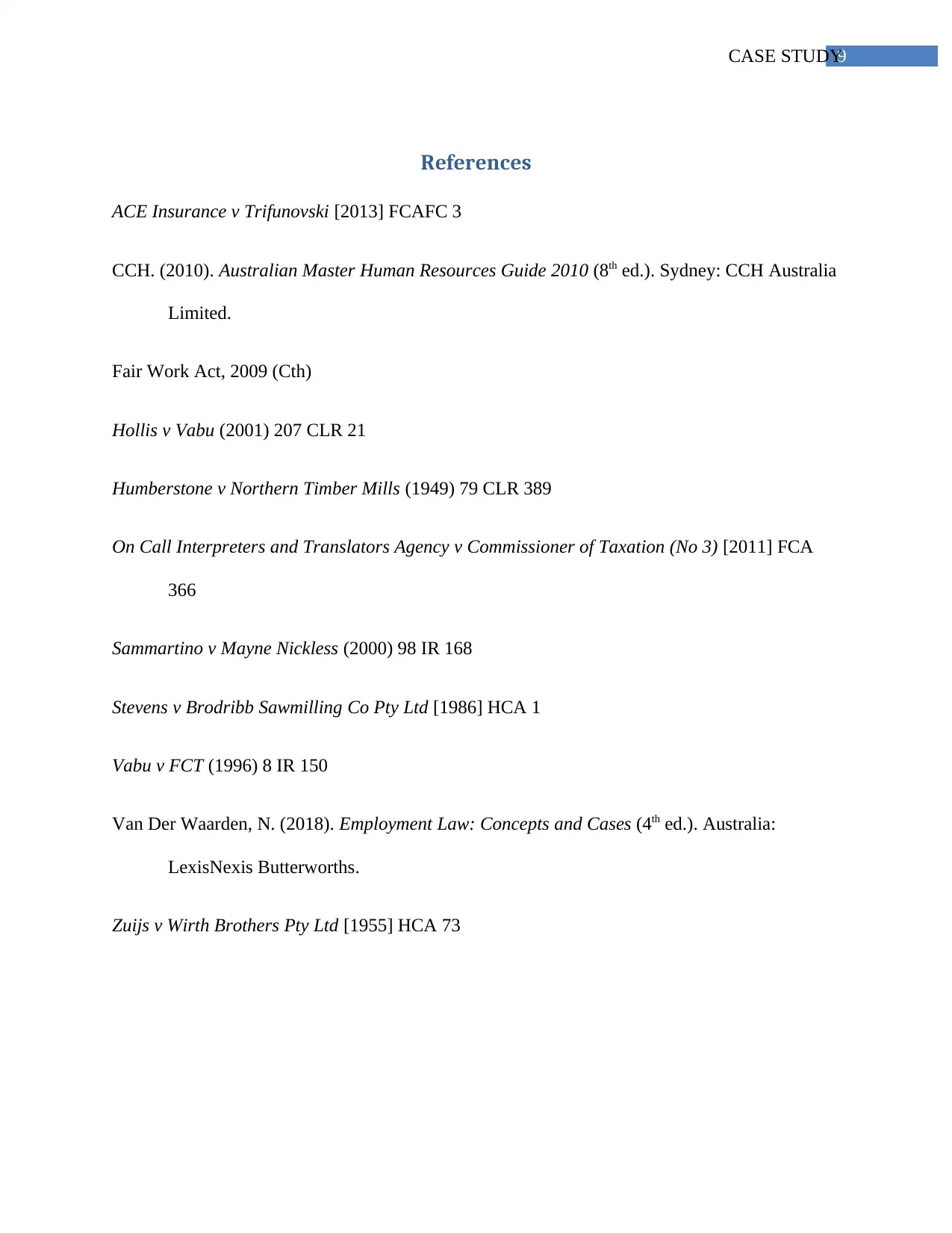
9CASE STUDY
References
ACE Insurance v Trifunovski [2013] FCAFC 3
CCH. (2010). Australian Master Human Resources Guide 2010 (8th ed.). Sydney: CCH Australia
Limited.
Fair Work Act, 2009 (Cth)
Hollis v Vabu (2001) 207 CLR 21
Humberstone v Northern Timber Mills (1949) 79 CLR 389
On Call Interpreters and Translators Agency v Commissioner of Taxation (No 3) [2011] FCA
366
Sammartino v Mayne Nickless (2000) 98 IR 168
Stevens v Brodribb Sawmilling Co Pty Ltd [1986] HCA 1
Vabu v FCT (1996) 8 IR 150
Van Der Waarden, N. (2018). Employment Law: Concepts and Cases (4th ed.). Australia:
LexisNexis Butterworths.
Zuijs v Wirth Brothers Pty Ltd [1955] HCA 73
References
ACE Insurance v Trifunovski [2013] FCAFC 3
CCH. (2010). Australian Master Human Resources Guide 2010 (8th ed.). Sydney: CCH Australia
Limited.
Fair Work Act, 2009 (Cth)
Hollis v Vabu (2001) 207 CLR 21
Humberstone v Northern Timber Mills (1949) 79 CLR 389
On Call Interpreters and Translators Agency v Commissioner of Taxation (No 3) [2011] FCA
366
Sammartino v Mayne Nickless (2000) 98 IR 168
Stevens v Brodribb Sawmilling Co Pty Ltd [1986] HCA 1
Vabu v FCT (1996) 8 IR 150
Van Der Waarden, N. (2018). Employment Law: Concepts and Cases (4th ed.). Australia:
LexisNexis Butterworths.
Zuijs v Wirth Brothers Pty Ltd [1955] HCA 73
⊘ This is a preview!⊘
Do you want full access?
Subscribe today to unlock all pages.

Trusted by 1+ million students worldwide
1 out of 9
Related Documents
Your All-in-One AI-Powered Toolkit for Academic Success.
+13062052269
info@desklib.com
Available 24*7 on WhatsApp / Email
![[object Object]](/_next/static/media/star-bottom.7253800d.svg)
Unlock your academic potential
Copyright © 2020–2025 A2Z Services. All Rights Reserved. Developed and managed by ZUCOL.





